Executive Summary
On October 26, 2019, the US forces embarked on a military operation in the village of Barisha[1] in the suburbs of Idlib Province. The operation ended with the death of the Iraqi leader of the Islamic State/ISIS/Daesh —Abu Bakr al-Baghdadi. Provided by President Donald Trump, the US official account of the operation reported that eight helicopters took part in the raid, during which the US Special Forces were shot at once arriving into the compound where al-Baghdadi hid. Trump also pointed out that the entrance to the compound was booby-trapped, adding that after he detonated a suicide vest, al-Baghdadi and three of his children died, in addition to two women who also had suicide vests on, along with two of the al-Baghdadi’s bodyguards. The Special Forces have evacuated 11 children from the operation’s site and placed them in the care of a third side.
The US account partially contradicts the accounts provided by eyewitnesses and testimonies obtained by Syrians for Truth and Justice/STJ and SMART News Agency from the operation’s site, where al-Baghdadi died. The general guidelines of the two narratives, however, match.
The US operation, Barisha-based eyewitnesses and locals reported, started when eight helicopters entered the Syrian airspace, hovered over the Turkish-Syrian border areas at a low altitude and head next to the village of Barisha, south of Idlib City. There, the helicopters’ machineguns began to fire. The village’s residents refuted the US claims that the US Special Forces have clashed with al-Baghdadi’s militants and his bodyguards. The witnesses, on the contrary, stressed that the helicopters exchanged machinegun fire with HTS-affiliated militants near the operation’s site, after the militants targeted the helicopters with anti-aircraft weapons, mistaking the helicopters for Syrian regular forces’ aircraft.
The clashes were followed by an airdrop in the surrounding of a house owned by a man called Rasheed Salameh, dubbed Abu Mohammad al-Halabi, as he is originally from Aleppo. Salameh arrived in the village a year and a half ago, where he started a grain trade and built himself a house on the outskirts of Barisha Village—the house, surrounded by a 3-meter-high fence, is of two stories and of 240 meters area. Two tents, housing people displaced from Homs and Hama, were also set up near the fence, from where the US Special Forces sneaked into the house and interrogated the people in the tents for about two hours, tied their hands behind their backs and then uncuffed and ordered them not to return until the operation was over. The operation, however, lasted for a few hours, and the eyewitnesses recounted that they could hear the sound of heavy shooting and successive blasts. The operation finally ended with the arrest of several people and the bombing of the house to a state of nonexistence.
A supervisor at one of the warplane observatories in Northern Syria said that aircraft, likely US-affiliated, entered the Syrian airspace from the north after 2:00 am on October 27, 2019, hitting Salameh’s house with four missiles, which caused its full destruction and leveled it to the ground.
Contrary to the US official account which reported the death of al-Baghdadi and three of his children, in addition to two women and a number of his bodyguards during the operation, several sources, who headed to the raid’s site after it finished, informed STJ that they managed to recover the body parts of three women and three children, one of whom appears to have been hanged to death, as they found rob marks on his neck, details which Trump did not mention in his televised release. The remains of an unknown heavyset man were also found while none of these persons’ identities has been identified. Two other men— the cousins Khalid Mustafa Qarmou and Khlaid Abdulmajeed Qarmou, were additionally found dead in a bus near the raid’s site, who, according to numerous sources and information obtained by STJ and SMART News Agency, had a passenger car and were both killed during the US operation in the village of Barisha. Several of the sources said that it was most likely that the two men were working as smugglers and were transporting people from Idlib to Turkey.
Trump’s release reported that the US forces have evacuated 11 children and placed them in the care of a third side. Commenting on this, sources from the Syria Civil Defense/SCD said that they found eight children, including three newborns, whom the forces have delivered to a resident of the tents set up near Salameh’s house. While none of these children were identified, HTS hurriedly held them captive and transported them to an unknown destination.
Shortly before the air raid, HTS, a number of sources added, ordered its militants and checkpoints, spreading in the area, to withdraw from it and not to aim at helicopters which were categorized as belonging to the Turkish army and were supposedly allocated technical tasks at the observation posts in Idlib’s suburbs, as a radio circular reported on the night of the operation.
STJ obtained numerous accounts of al-Baghdadi’s movement to Idlib Province prior to his death during the US raid. However, the information, provided by local activists and sources, who preferred to stay anonymous, mostly stressed that al-Baghdadi has moved to Idlib Province about 7 or 8 months prior to the operation, in sync to the waves of displacement that sought Idlib from Deir ez-Zor Province, for several of the sources pointed out that al-Baghdadi was hiding in Idlib.
Additional information indicate that HTS had succeeded in locating al-Baghdadi a month before the US raid in the town of Sarmin, rural Idlib, and that it attempted to raid his hiding place, from where he managed to escape back then.
The US raid that resulted in al-Baghdadi’s death, according to STJ’s field researchers, has inflicted massive material damage on a number of civilian houses, located near the raid’s site, adding that the civilians sought protection in the rear parts of their houses during the operation, which spared their lives.
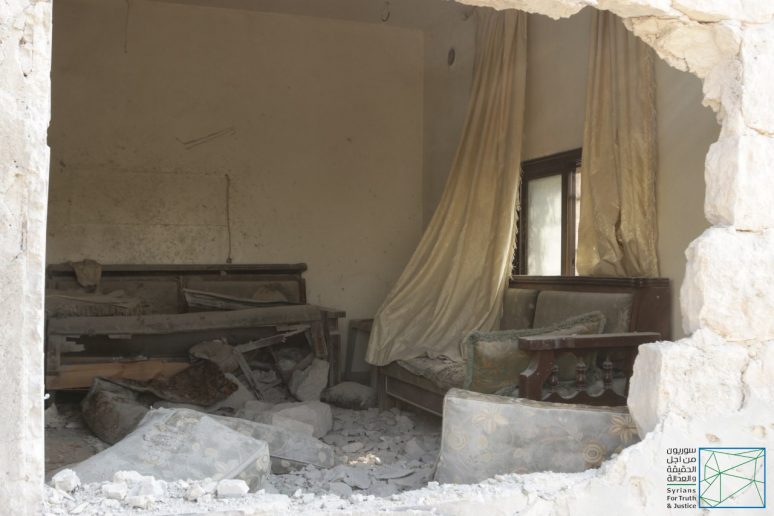
Photo no. (1).
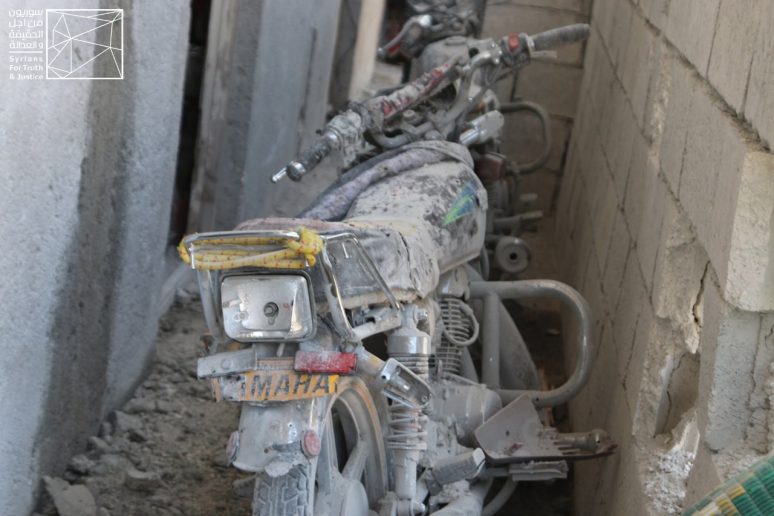
Photo no. (2) – both photos show the destruction that befell civilians’ houses, located near that of Rasheed Salameh, affected by the US operation that resulted in the death of al-Baghdadi. Photo credit: STJ.
A number of military operations by the forces of the US-led coalition preceded the US raid that targeted al-Baghdadi, which aimed at military strongholds affiliated with Islamic extremist groups in the provinces of Idlib and Aleppo. On August 30, 2019, the coalition’s forces attacked a military post of the Ansar al-Tawhid, northern rural Idlib, taking a toll on up to 30 of the armed group’s fighters, including under-18 recruits, and rendering over 36 other fighters injured. The attack’s shrapnel also downed dead a 70-year-old civilian called Ahmad Yousef while cultivating his land, in addition to injuring other four civilians, a woman included, from rural Idlib, who were also working in their agricultural lands near the attack’s location.
On July 30, 2019, the coalition’s forces undertook another attack against a military post of the Hurass ed-Din/Guardians of Religion Organization, western rural Aleppo. The attack targeted a Religious Institute, causing the death of no less than eight persons, including three scholars and five of the Organization’s commanders, in addition to 12 wounded others, some of whom were critically affected.[2]
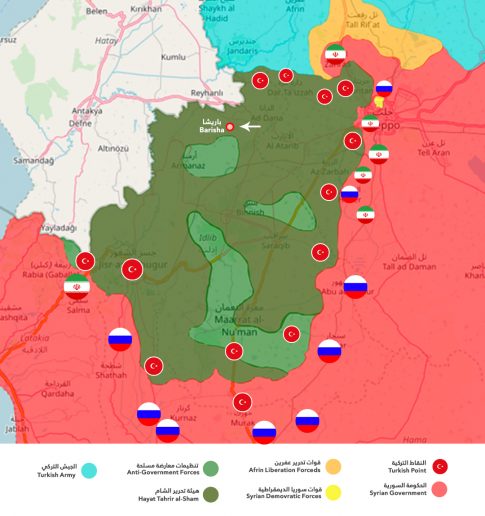
Image no. (3) – map indicating control areas in Idlib Province and the areas surrounding it on October 26, 2019, in addition to the locations of the Turkish, Russian and Iranian observation posts.
1. Report Methodology:
In terms of methodology, the report is based on more than (17) testimonies and interviews, conducted either online or in person with eyewitnesses by STJ’s field researchers and SMART News Agency from early November to mid-December 2019, in addition to referencing numerous open sources that documented the incidents mentioned in the report.
2. Who Is Abu Bakr al-Baghdadi?
Al-Baghdadi, whose true name is Ibrahim Awad Ibrahim al-Badri, was born in 1971 in the city of Samarra, north of Baghdad, to a religious financially modest family, belonging to the al-Badri Tribe and claiming being the decedents of Prophet Mohammad. Al-Baghdadi spent his childhood and teenage years in the city of Samarra before he moved into the Iraqi capital city Baghdad at 18.
In 1996, al-Baghdadi gained a bachelor’s degree in Islamic Studies from the University of Baghdad and then a master’s degree and a PhD in Qur’anic Studies from the Saddam University for Islamic Studies between 1999 and 2007. Up to 2004, al-Baghdadi spent his higher education years at the al-Ttoubaji Neighborhood, north-western Baghdad. Back then, except for teaching Quran to children in a local mosque, al-Baghdadi was known for being an introvert quiet person. It was not also certain if he embarked on any noteworthy political activities within the ranks of political Islam.
It is believed that al-Baghdadi started to show an inclination towards hardliner Salafist groups, which favor violence, in 2000. It was when he adopted the cult of Salafi Jihadism. In the wake of the US invasion of Iraq and its occupation in 2003, al-Baghdadi contributed to the foundation of an armed group— Jaysh Ahl al-Sunna wa’al Jamma/ Jamaat Ansar al-Sunna. The US forces arrested him in February 2004 in the city of al-Fallujah, and he spent about 10 months in the detention facility at Camp Bucca — a prison that resembled a university from where the future leaders of ISIS graduated, as it was the assembly point for a large number of extremist Islamic groups’ iconic personalities.
While in detention, al-Baghdadi spent his sentence preaching to detainees, leading them in the prayers and delivering the Friday ceremony, in addition to lecturing them on matters of religion. In the Camp Bucca, al-Baghdadi built strong ties with serval of the persons detained with him and kept in touch with them after his release in December 2004, given that he was let out after the US classified him as a source of low threat.
Following his release, al-Baghdadi contacted the spokesperson of al-Qaeda in Iraq, a local Iraqi organization affiliated with al-Qaeda which was led by the Jordanian Abu Musab al-Zarqawi, who was impressed by al-Baghdadi’s level of education and convinced him to travel to Damascus, the Syrian capital, where he was to work for ISIS propaganda apparatus and help supervise the advertorial materials published by the organization, as to make sure that they all matched with the principles of Salafi Jihadism.
Al-Baghdadi held a tight bond with the leader of al-Qaeda in Iraq, Abu Musab al-Zarqawi. Early in 2006, the al-Qaeda Organization in Iraq launched a new Jihadi umbrella body called Mujahideen Shura Council.
In the aftermath of Abu Musab al-Zarqawi’s death in a US raid in July 2006, Abu Ayyub al-Masri occupied the position of the al-Qaeda leader in Iraq.
In October 2006, Abu Ayyub al-Masri decided to dismantle al-Qaeda in Iraq and establish the Islamic State Organization, which continued to express loyalty to the mother organization al-Qaeda. Al-Baghdadi was fast to become a star within ISIS ranks, given his qualifications in the field of Islamic Studies and his ability to redeem the gap between the foreign fighters who established the organization and the Iraqi fighters that joined it later. In no time, he managed to reach the top of ISIS leadership ladder.
Al-Baghdadi was assigned the head of the Sharia Committee of ISIS and was selected to be a member of its Shura Council and then to be a member of the Coordination Committee of the al-Qaeda in Iraq which supervised the process of communication with the leaders of the organization there. In 2010, however, the Shura Council assigned Abu Bakr al-Baghdadi the new prince of ISIS after the death of Abu Omar al-Baghdadi, the organization’s founder and prince.
Al-Baghdadi managed to rebuild the organization, very much exhausted by the assaults of the US Special Forces after the spark of demonstrations, known as the Arab Spring, reached Syria from Tunisia and Egypt in 2011. Al-Baghdadi made use of the domestic unrest and sent one of his Syrian assistants, Abu Mohammad al-Julani, to start a ISIS branch in Syria, which was later known as Jabhat al-Nusra/al-Nusra Front. Nonetheless, a split was fast to appear between al-Baghdadi and the commander of al-Nusra Front, al-Julani, who wanted to cooperate with the groups that opposed the Syrian Government.
Al-Baghdadi, in 2013, announced al-Nusra Front as a part of ISIS in Iraq and modified the organizations name to be the Islamic State of Iraq and the Levant/ISIL, denying al-Nusra Front its independence, which the leader of the mother al-Qaeda Organization, Ayman al-Zawahiri, demanded. In response, the latter declared severing its relations with the al-Qaeda and ISIL in February 2014. Al-Baghdadi, for his part, along with his organization, retaliated by fighting al-Nusra Front and tightened his grip over several areas in north-eastern Syria, where he ordered a strict application of Islamic Sharia rulings.
Upon securing a safe stronghold for his organization, al-Baghdadi ordered his followers to advance into the western areas in Iraq in late 2013, exploiting the political dispute between the Sunni and Shiite parties and groups over power. Backed by tribal men and loyalists to the former Iraqi President Saddam Hussain, he managed to take over al-Fallujah.
On July 29, 2014, ISIL announced changing the name of the organization to Islamic State/IS in a voice note, thus, omitting the Levant and Iraq, seeking to erase borders between the areas encompassed by the claimed state.
In mid-June 2014, IS have had already controlled the province of Raqqa in Syria and several areas in the province of Deir ez-Zor, the ones near the Iraqi borders, in addition to vast areas in the province of Aleppo.
As IS control areas grew bigger, al-Baghdadi announced Raqqa the capital of the Caliphate, calling Muslims to emigrate to it and pledge him alliance.
In the IS-held areas, the population suffered cruel penalties, assassinations on public squares and the imposition of strict regulations, which were to cover all the people regardless of their religious or sectarian affiliations.
The biggest of IS victories was, nonetheless, the control over the city of Mosul, the capital of Ninawa Province, and large areas in northern Iraq following the withdrawal of Iraqi forces, in addition to getting hold of massive amounts of the retreating forces’ heavy arms.
In 2014, IS managed to rule over about 8 million persons in a geographical spot of about 88 thousand square kilometers, while it also succeeded in making millions of dollars, as oil, robbery and kidnaping revenues.
IS progress into Kurdish-controlled areas in Northern Iraq, where it killed and enslaved thousands of Yazidis, triggered the US-led coalition to launch several raids against IS strongholds in Iraq in August 2014.
Following IS control over the city of Mosul, Northern Iraq, in 2014, al-Baghdadi appeared for the first time to announce the foundation of the Caliphate State and crowned himself the Caliph, when he delivered the Friday ceremony at the al-Nouri Mosque in Mosul. On April 29, 2019, five years into his first appearance, Abu Bakr al-Baghdadi showed himself for the second time to stress that IS will continue the holly war/Jihad and promised to embark on a war that is to drain IS enemies. In a video, published by IS back then, he also called onto his followers around the world to seek Jihad.
3. US Official Account of al-Baghdadi’s Death Raid:
The US President Donald Trump stated[3] that the US forces have undertaken an operation that resulted in the death of Abu Bakr al-Baghdadi, the leader of IS, known by the Arabic acronym Daesh.
Al-Baghdadi, Trump said, died after he below up the suicide vest he had on, adding that the latter was accompanied by three of his children and that “his body was mutilated by the blast, but test results gave certain and positive identification.” In the statement, the president added that:
“He died after running into a dead-end tunnel, whimpering and crying and screaming. I want to thank the nations of Russia, Turkey, Syria and Iraq, and I also want to thank the Syrian Kurds for certain support they were able to give us.”
In further details on the raid, the US President Donald Trump said,[4] in a speech made on the raid’s morning during a press conference at the White House, that eight helicopters participated in the operation and that the entrance to the compound where al-Baghdadi and his men were fortified was booby-trapped, adding that the US forces were met with a massive shooting by al-Baghdadi’s guards.
A large crew of brilliant fighters ran out of those helicopters and blew holes into the side of the building, not wanting to go through the main door because that was booby-trapped, Trump added.
The US President continued, saying that the US Special Forces’ dogs have chased al-Baghdadi all the way through a tunnel, until he reached a dead end, and it was there were he ignited his vest. Trump pointed out that eight helicopters participated in the operation and spent about two hours flying over the operation’s area at a low altitude.
Two women, Trump added, also died with al-Baghdadi, and that they both had suicide vests on. He said that a number of al-Baghdadi’s thugs were there, who surrendered and are under arrest, while a massive number of his guards, with whom the US forces clashed, got killed, in addition to 11 children who were removed from the operation’s location and were delivered to a third party.
Trump added that the US forces have obtained special documents from the site where al-Baghdadi was killed, in addition to the arrest of several people who surrendered inside the residential compound, pointing out that the US forces have received very positive information on the al-Baghdadi’s whereabouts a month ago, accentuating that “we managed to scope out al-Baghdadi two weeks ago.”
After this press release, there were statements[5] by Marine Gen. Kenneth F. McKenzie Jr, the commanding general of the US Central Command, during a press conference at the Pentagon on October 31, 2019. He said that six IS fighters fell dead during the raid, including al-Baghdadi and another man. He added that two children died in the tunnel with al-Baghdadi, not three as the US President Donald Trump announced. He also mentioned that four women, who had suicide vests on, died, contrary to the details offered by the president, who said that two women died in the raid. McKenzie also said that “I want to make it clear that despite the violent nature of the raid and the high-profile nature of this assault, every effort was made to avoid civilian causalities and to protect the children that we suspected would be at the compound.”
“Following collection of samples for formal DNA analysis, Baghdadi’s remains were buried at sea in accordance with the law of armed conflict within 24 hours of his death,” he added.
4. Testimonies and Eyewitness Accounts of al-Baghdadi’s Death Raid:
Parts of the US official account of the military operation conducted by its forces to terminate the leader of IS, Abu Bakr al-Baghdadi, in the village of Barisha, the province of Idlib, contradict with the accounts provided by the village’s locals and the SCD’s teams, who recovered the dead bodies from the operation’s sit. The tow accounts, however, match when it comes to the general guidelines.
A. Helicopters Enter the Syrian Airspace:
According to several testimonies and accounts by eyewitnesses, based in the village of Barisha, 51 kilometers to the north of Idlib City, where the IS leader Abu Bakr al-Baghdadi died, which STJ and Smart News Agency obtained, on Saturday night, October 26, 2019, eight Apache helicopters made their way into the Syrian airspace, flying somewhere near the Syrian-Turkish border. Around 11:00 pm, the helicopters reached Barisha Village, northern Idlib, close to the house of a person called Rasheed Salameh, dubbed Abu Mohammad al-Halabi, who is originally from the Province of Aleppo. Salameh has actually arrived in the village a year and a half ago, where he built a house, the one where a real war was waged for a few hours in a small spot, ending with the death of Abu Bakr al-Baghdadi.
One of the supervisors at a warplane observatory in Northern Syria reported that eight Apache helicopters entered the Syrian airspace, coming from the direction of the northern Syrian borders with Turkey on Saturday night. He added that reconnaissance aircraft were hovering over the place from 11:00 pm to 3:00 am on Friday at dawn.
Offering a second account, Khalid al-Najar, a local of Barisha Village, said that the raid, conducted by the US forces, targeted a house on the outskirts of Barisha Village, consisting of two stories and of 240 meters area, which a 3-meter-high fence surrounds, adding that two tents, incubating persons displaced from Homs and Hama, were also set up near that fence.
In an attempt to obtain further information about the house owner, Rasheed Salameh, it became clear that he was born in the al-Nayrab Neighborhood in the city of Aleppo and that he moved in the village of Barisha a year and a half ago, where he started trading in grain. Salameh and his son were both arrested during the operation.
On a different note, the residents of the village of Barisha refuted the US narrative on the clashes that erupted between the US Special Forces and al-Baghdadi’s followers or his personal guards, for several of them have accentuated that the helicopters, before they reached Salameh’s house, exchanged machinegun fire near the raid’s site with HTS-affiliated fighters — the machineguns used were medium B.K.Ss—after the fighters aimed at the helicopters with anti-aircraft weapons, mistaking them for the Syrian Air Forces and given that the helicopters targeted the HTS fighters from a low height rendering a number of them injured.
In a cross-referenced testimony, Ahmad al-Mohammad, one of the village’s locals who were near the raid’s site, stressed that several of the village’s people have shot at the helicopters using their machineguns, thinking that they were affiliated with the Syrian regular forces. The clashes caused the injury and the hospitalization of a civilian, who got wounded by the helicopter fire.
B. The Airdrop:
According to several accounts delivered to STJ and Smart News Agency by eyewitnesses and residents of the Barisha Village, who were near the attack’s site, six helicopters landed in the surrounding of Salameh’s house.[6] Other helicopters, nonetheless, kept hovering above the house. Then, the US Special Forces sneaked into the house after they opened a hole in the northern part of the fence surrounding it.
Abu Khalid, one of the persons displaced from rural Hama and who resided in one of the tents erected in the rear part of the fence around Rasheed Salameh’s house, narrated the following:
“The US forces, which conducted the raid, have interrogated us for less than two hours. Once they entered the tents, the forces tied our arms behind our backs and started asking us about our relationship with Rasheed Salameh. When they were sure that we did not know much about him, they untied us and through an Arabic translator ordered us to go away from the house aboard our cars. They gave us laser device and warned us not to return until the US forces have left the place.”
Abu Ahmad, a second witness and also a resident of the tents, set up near Salameh’s house, said that the US forces have held him captive for two hours after they cordoned the house. He added that several troops entered his tent and started interrogating him about Salameh and the type of relationship they had. They then cuffed him and detained him, with his family, inside the tent, continuing to say that the troops landed in Salameh’s house and started saying phrases in Arabic, such as “Abu Mohammad Salameh surrender”, assisted by a Jordanian translator who was there with them. And then, he began to hear the sounds of clashes, shooting and explosions.
The witness pointed out that the US troops planted mines inside the house and patched others to the fence. They, then, asked him and his family to leave the place and never to return until the sounds of explosions have faded down.
The supervisor at one of the warplane observatories in Northern Syria added that aircraft, most likely US-affiliated, have entered the Syrian airspace from the north after 2:00 am on October 27, 2019 and bombarded Salameh’s house with four missiles that completely destroyed it and leveled it to the ground.
Another warplane observatory stressed that the border area with Turkey as far as Ma’arrat Misrin has witnessed unprecedented activity on the part of the reconnaissance aircraft 48 hours before the raid, the aircraft are believed to belong to the US-led coalition forces. The scanning, back then, covered the cities and towns of al-Dana, Sarmada, Harem, Darkoush and Ma’arrat Misrin, in addition to the villages and towns surrounding these areas, adding that, in sync, Idlib Province, its southern, eastern and western parts included, was a sight to continuing activity by Russian surveillance aircraft.

Photo no. (4) – the destruction that befell the building targeted during al-Baghdadi’s death raid. Photo credit: STJ.

Photo no. (5) – analysis of available visual evidence.
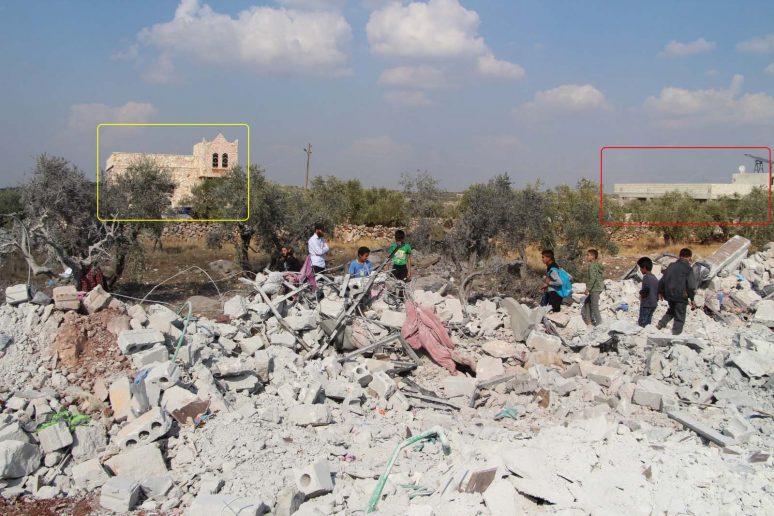
Photo no. (6) – analysis of available visual evidence.
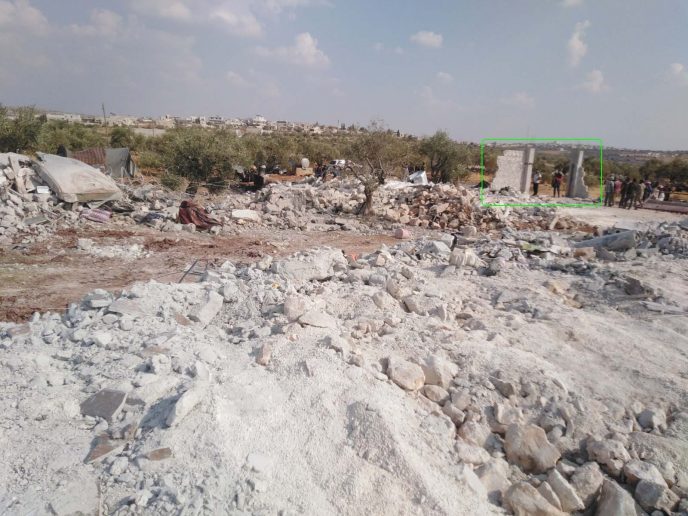
Photo no. (7) – analysis of available visual evidence.

Photo no. (8) – analysis of visual evidence of the raid’s site where al-Baghdadi was killed.
5. Al-Baghdadi’s Death Operation Renders many Dead:
On Sunday morning, October 27, 2019, an armed segment of HTS stroke a security cordon around the site of the US raid that killed al-Baghdadi.
Contrary to the US official account which declared the death of al-Baghdadi and three of his children, in addition to two women and a number of his guards during the raid, the SDC’s teams have recovered the remains of three unidentified women, three children and an unknown heavily built man inside the targeted building, as well as the bodies of other two men, who were found on a bus near the attack’s site—the men work in the field of transportation—according to what a source of the SDC has reported to Smart News Agency, who said that one of the three dead children’s bodies that they recovered showed strangling marks, as they found robe traces on the child’s neck. This incident was not mentioned in Trump’s televised speech, which did not report the death of any children at the operation’s site, one of whom was strangled.
Sources of the SCD also reported finding eight children, including newborns, whom the US forces have placed in the care of the residents of the tents near Rasheed Salameh’s house, whose identity was unknown. HTS, for its part, hurried to detain those children and transported them to an unidentified destination while the SCD’s teams worked on burying the dead bodies in a cemetery in Barisha Village.
Another source told STJ that the SCD has recovered the bodies of three women, three children and three men, pointing out that two of the dead men’s bodies were found on a bus, for the two were transporting people from Syria into Turkey. Commenting on this, several sources and eyewitnesses said that it is most likely that these two men were smugglers, transporting people from Idlib to Turkey, who by chance were passing near the site where the US raid that killed al-Baghdadi was conducted.
According to Smart News Agency, the two men, whose bodies were found on a bus near the raid’s location, were identified as Khalid Mustafa Qarmou and Khalid Abdulmajeed Qarmou, paternal cousins who have a passenger car. The men were killed during the US operation in the Barisha Village. A relative of the two dead men, Ahmad Mustafa Qarmou, based in Barisha, said:
“My brother Khalid Qarmou, who has a passenger car, was killed in one of the US raids on the village on October 26, 2019, while on the way from Barisha to Hitan Village. My brother was the breadwinner of his family, consisting of four children, the older of whom is nine years old. He left them no resources behind.”
For his part, Mahmoud Abdulraheem Qarmou, said that his cousin Khalid Qarmou was killed in one of the US raids that targeted IS leader Abu Bakr al-Baghdadi, pointing out that his cousin was based in the village of Ttour Laha, north of Idlib, driving a civil car that transports passengers between the villages and towns of Sarmada, Barisha and Hitan. He happened to enter the Barisha town, accompanied by his cousin Khalid Mustafa Qarmou, during the US operation, which rendered them both dead.
His cousin Khalid Abdulmajeed Qarmou, Mahmoud Qarmou, continued to say, was the head of a family of two children, who were left no breadwinner following the death of their father. Mahmoud pointed out that the two victims, Khalid Mustafa Qarmou and Khalid Abdulmajeed Qarmou, are civilians and had no links what so ever with any of the armed groups, adding that they both had a car that transported passengers between the towns and villages of Northern Syria. They were driving their car from Rass al-Hisn Village to that of Hitan and were both killed during the US operation as they passed through Bariha village, leaving behind their two families to battle with poverty and suffering.
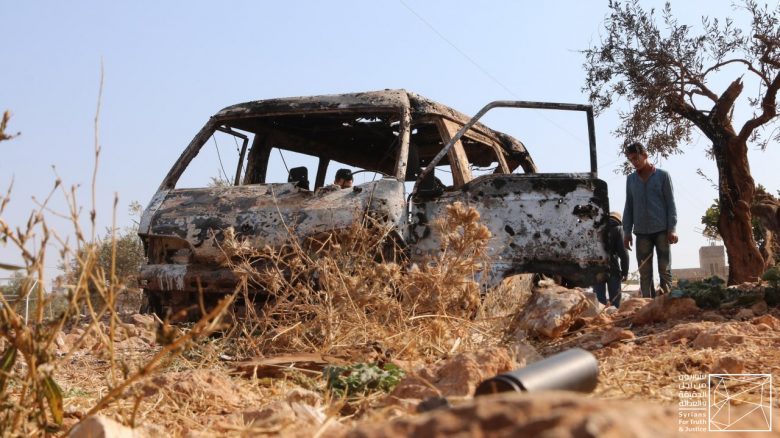
Photo no. (9).
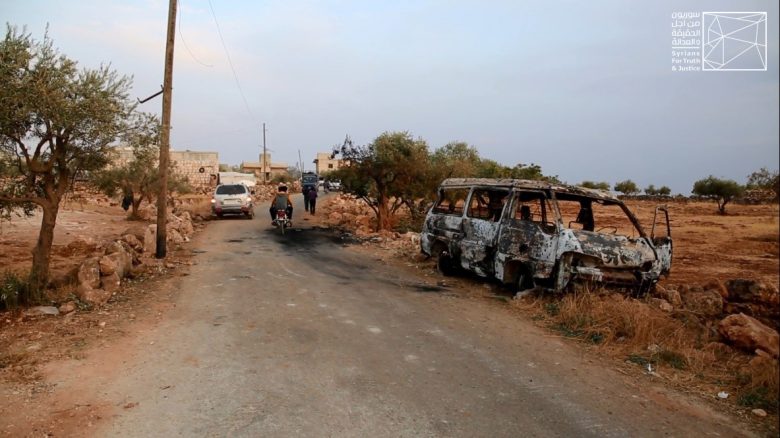
Photo no. (10) – the two photos 9 and 10 show the destruction that befell the bus, near the location of the US operation that resulted in the al-Baghdadi’s death. Photo credit: STJ.
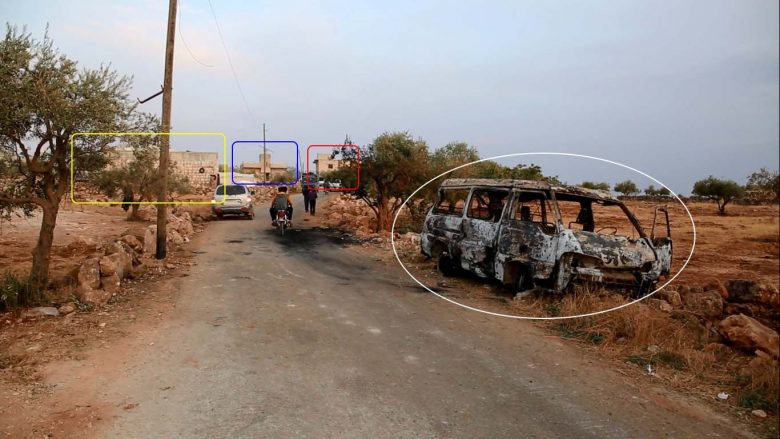
Photo no. (11).
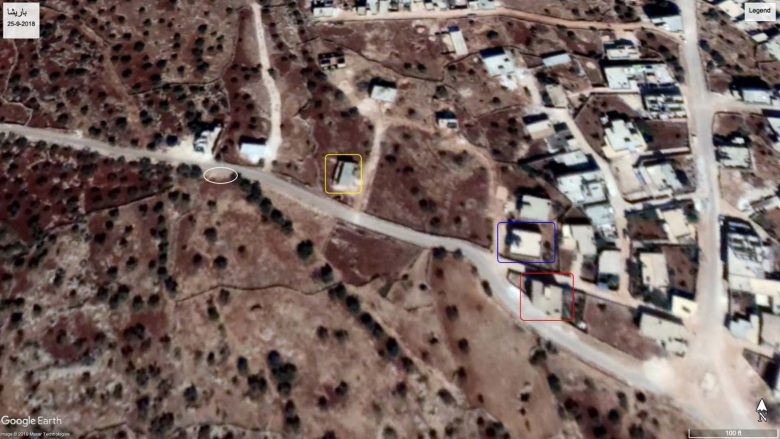
Photo no. (12) – the two photos are an analysis of the visual evidence, in which a bus appears destroyed near the location of the US operation that resulted in the al-Baghdadi’s death.
6. Videos from the Raid’s Site Analyzed:
On October 30, 2019, the US State Department of Defense published videos and footage of the operation that caused the death of IS leader Abu Bakr al-Baghdadi in Northern Syria.[7] In one of these videos, the target building appears prior to being hit by the US forces.
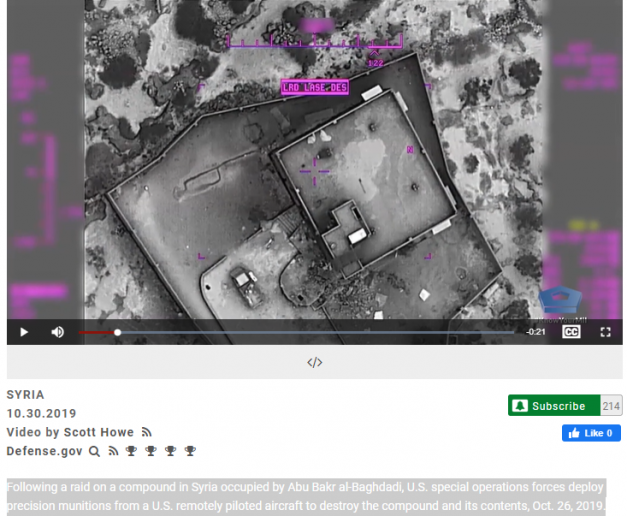
Photo no. (13) – footage taken from the above-mentioned video, showing the building targeted by the al-Baghdadi’s death raid.
Another video showed several persons escaping the residential compound,[8] whom the helicopters aimed at with a shooting craze and on which McKenzie commented on saying that they were fighters who resisted the US forces and were combated by the helicopters.
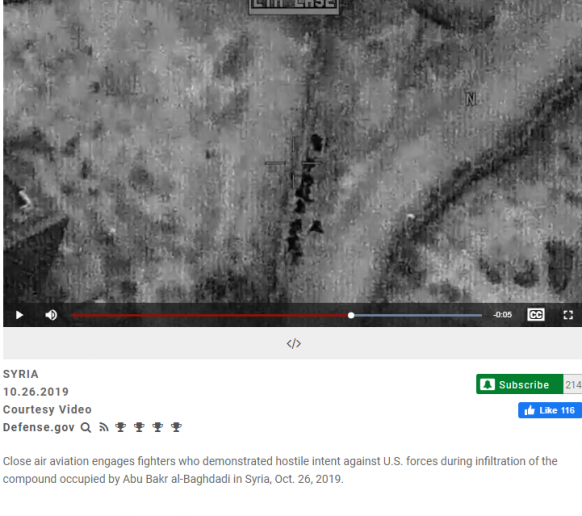
Photo no. (14) – footage taken from the above-mentioned video, showing several people escaping the residential compound where al-Baghdadi was killed.
Another video, released by the US State Department of Defense,[9] shows US troops on foot, approaching a building with a high fence in Northern Syria, where al-Baghdadi was encircled.
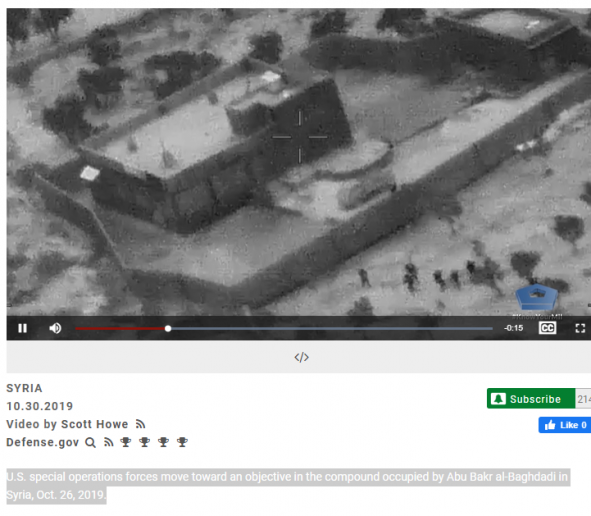
Photo no. (15) – footage taken from the above-mentioned video, showing US troops on foot, approaching a building with a high fence in Northern Syria, where al-Baghdadi was encircled.
In another video, documenting the US operation which resulted in the death of al-Baghdadi,[10] a pillar of smoke rises in the sky after the US forces’ bombs leveled al-Baghdadi’s compound to the ground, which stresses that the house was violently hit, a thing that eyewitnesses spoke about.
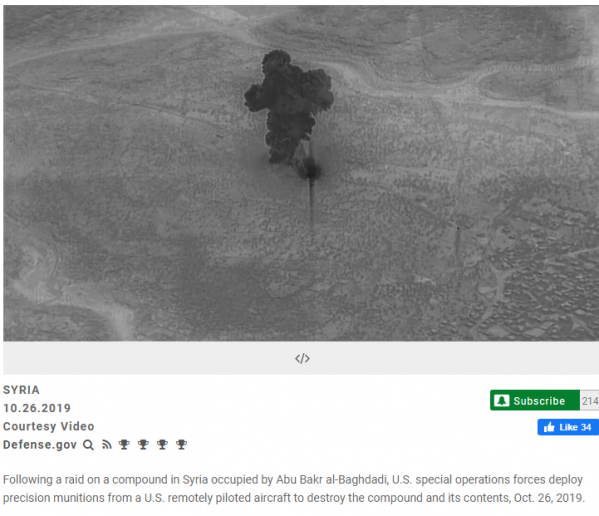
Photo no. (16) – footage taken from the above-mentioned video showing a pillar of smoke rising in the sky after the US forces’ bombs leveled the targeted compound, where al-Baghdadi was encircled, to the ground.
One of the photos released by the US state Department of Defense showed the targeted location prior to the attack and after it was conducted during the operation that caused the death of al-Baghdadi.[11]
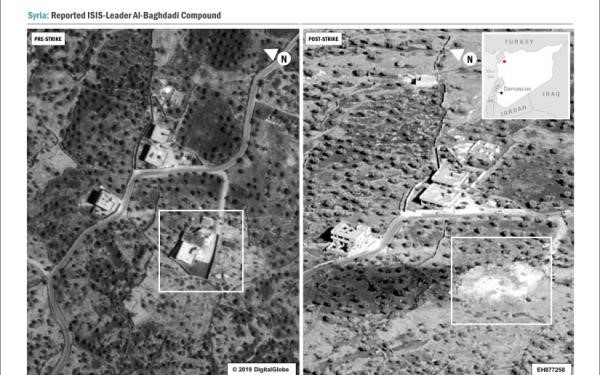
Photo no. (17) – showing the targeted location prior to the attack and after it was conducted during the operation that caused the death of al-Baghdadi.
7. Was HTS Already Informed of the Raid?
HTS checkpoints and posts witnessed an unprecedented state of alert about 18 hours before the US forces carried out the raid that killed al-Baghdadi, for a media activist in Idlib stated to STJ that checkpoints separating HTS-held areas from those controlled by the Turkey backed factions of the National Army, north of Aleppo, have witnessed a large-scale mobilization starting on the morning of October 26, 2019.
The HTS-affiliated Deir Ballut checkpoint, located north of Idlib, the witness added, searched the vehicles heading to the Euphrates Shield areas, in addition to the accurate inspection of the identity documents of both men and women who passed by the checkpoint.
The witness also emphasized that when he was stopped at the checkpoint, he could see that the militants there were unusually heavily armed while they conducted checkups of the passers’ background, using a computer that he has never seen at the checkpoint before.
Activist Ali al-Hamwi, for his part, told STJ that HTS checkpoints rarely stopped vehicles passing by in the Jabal al-Zawiyah area, south of Idlib, and in al-Ghab Plain, west of Hama. On the 26th and 27th of October, however, there was something unusual about the checkpoints, for the militants there started to search cars and verify the identity documents of women and men since morning. The checkpoint personnel also searched personal belongings and stopped every vehicle, including motorcycles.
Al-Hamwi added that these areas, whether Jabal al-Zawiya or al-Ghab Plain, had not witnessed such an intensification and mobilization before, and stressed that the state of alert reached its peak by evening, indicating that the personnel of the checkpoints did not leave at night that day, which calls for doubt that HTS was already informed that a security operation was to be conducted in its area.
In this regard, an officer, a defector from the Syrian regular forces in Idlib Province, told STJ that it was unlikely that HTS was not already informed of the US operation, especially since it did not show any military effort or deploy heavy vehicles to confront the US helicopters which took hours to finalize their operation, as HTS was able to bomb helicopters with the machineguns it stores in warehouses close to the Turkish border. He added that Turkey also was not out of the operation which the US conducted via helicopters that hovered over its borders with Syria.
Rami al-Ibrahim, another Idlib-based activist, confirmed that the series of assassinations and arrests that HTS has recently carried out against prominent IS officials is an evidence of its knowledge of IS high-ranking leaders movements and those who lately sought refuge in Idlib. Ibrahim added that HTS has carried out several assassinations and arrests of top IS officials, including al-Baghdadi’s personal esquire and his driver, dubbed Abi Abdullattif al-Jabouri while raiding an IS cell in Darat Izza, north-western Syria in July 2019. Back then, the interrogation of al-Jabouri indicated that he was assigned by IS to operate the sleeper cells in the province of Idlib and to enlarge their scope of action. On July 30, 2019, HTS security service also announced the death of Abu Dua al-Irani, an explosives engineer at IS in “Idlib State” in a raid that the service carried out in Saraqib, eastern Idlib.
Al-Ibrahim added that after the arrest of al-Jabouri and the death of al-Irani, HTS has chased to death on the Salqin-Darkoush road, western Idlib, both Ahmad Abdulbast al-Shahad, born in the town of Ma’ar Shoreen, south of Idlib and dubbed Abu Abdo Shdeed, the governor of Idlib State under IS, and his escort Abdullah Khalid al-Abbas, known as Abu Khalid Talmines, in August 2019. This haunt was followed by raid and arrest operations which made a target of IS officials, especially the General Director of IS cells in Idlib, Hama and Aleppo, in addition to his deputy director.
Al-Ibrahim pointed out that these raids, arrests and assassinations carried out by HTS against these figures may indicate that it was aware that a plan was being set up to move IS leader Abu Bakr al-Baghdadi into Idlib Province, adding that the US-led coalition or any military or security force in the world would obtain its information exclusively from security personnel and cannot rely on civilian informants, adding that no matter how advanced the air surveillance is it cannot identify persons unless there is surveillance and affirmation from the ground.
Wishing to remain anonymous, a local source told STJ that HTS ordered its militants and checkpoints, deployed in the area, shortly before the US raid to stay away from the operation’s area and not to target the helicopters, which were classified as Turkish army-affiliated and that were assigned technical tasks at the observation posts in rural Idlib in the radio circular on the operation’s night.
8. HTS Position of the Operation:
HTS did not clearly comment on the US Special forces’ killing of IS leader Abu Bakr Al-Baghdadi in its control areas, and its response was limited to the statements and voice notes of its followers and people known to belong to the tight circles of the al-Julani, such as a person called Abdullah al-Muhaissni, a Saudi former sharia scholar at HTS, who released a voice recording on the fourth day into al-Baghdadi’s death, in which he hailed the operation on the pretext that al-Baghdadi was using religion to cloak his plans and goals.[12] Al-Muhaissni also pointed out that the end of every tyrant and oppressor must resemble that of al-Baghdadi, who once controlled the lives of millions of people.
9. Multiple Narratives Address al-Baghdadi’s Movement into Idlib Province:
Numerous accounts were obtained by STJ concerning al-Baghdadi’s arrival to Idlib Province before he died in the US raid. However, a large portion of the information, delivered to STJ by activists or local sources, who preferred to remain unidentified, stressed that it was likely that al-Baghdadi has come to Idlib Province about 7 or 8 months before the US operation, in conjunction with the waves of displacement that occurred then from Deir ez-Zor to Idlib, where many sources indicated that al-Baghdadi kept a low profile in Idlib.
Other information indicated that HTS had managed to locate al-Baghdadi a month before the US operation in the town of Sarmin in rural Idlib and that HTS had attempted to raid his hiding place, but he managed to escape at the time. Another source, however, said that al-Baghdadi had arrived at the site of the US operation 7 or 8 hours before it was carried out.
In an investigative report published in late October 2019,[13] the New York Times revealed that the Central Intelligence Agency/CIA first got surprising information about al-Baghdadi’s location in a village deep inside a part of northwestern Syria, which is controlled by rival al-Qaeda groups. The information came after the arrest and interrogation of one of al-Baghdadi’s wives, pointing out that the CIA later cooperated with the Iraqi intelligence services and the forces they are already in contact with in Syria as to gather the largest amount possible of information on al-Baghdadi’s activities, including having informants in the place where he resided.
IS, according to the newspaper, has paid dozens of thousands of dollars to Hurass ed-Din/Guardians of Religion Organization to protect al-Baghdadi in the province of Idlib, Northern Syria, where al-Qaeda militants do spread, adding that al-Baghdadi sought refuge at the house of a leader of the Guardians of Religion called Abu Mohammad Salameh, amidst the secrecy of the relationship that brought together the latter and al-Baghdadi.
10. Assassinations after al-Baghdadi’s Death:
The killing of al-Baghdadi was followed by a number of assassinations that targeted IS officials, as helicopters carried out airstrikes on October 27, 2019, aiming at cars loaded with fuel tanks on the Ain al-Baida road near the city of Jarablous, north of Aleppo.
Local sources told STJ that two cars and a truck intended for transporting crude oil had been targeted by a raid on a side road between the villages of Ain al-Baida and Yusuf Beik, south of the city of Jarablous, during which about five people were killed, one of them was hiding inside the vehicle dedicated to transporting oil.
The sources added that these vehicles were coming from the city of Manbij, which is controlled by the Syrian Democratic Forces/SDF that the Kurdish Units dominate. The vehicles were heading towards northern rural Aleppo, where they were targeted less than an hour after entering the areas of the Turkey-backed National Army, near the Aown al-Dadat crossing that separates the two sides.
The aforementioned raids, according to SDF officials, targeted a person called Abu Hassan al-Muhajir, an IS spokesman and one of the most prominent aides of Abu Bakr al-Baghdadi. Mazloum Abdi, the SDF commander-in-chief, mentioned the following on his Twitter account: “Continuing the previous operation, the terrorist Abu Hassan al-Muhajir was targeted, the right-hand man of Abu Bakr al-Baghdadi and the spokesman of the Daesh [ISIS] organization, in the village of Ayn al-Baida near Jarablous, in direct coordination between SDF intelligence and the US Army, which came as part of the continuing pursuit of Daesh leaders.”
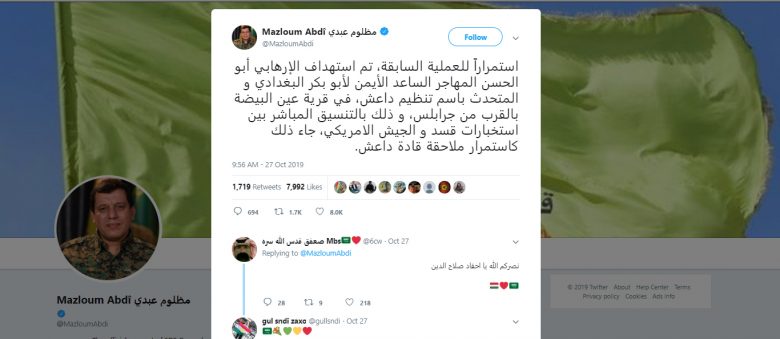
Photo no. (18) – SDF commander-in-chief General Mazloum Abdi’s tweet on the death operation of al-Baghdadi’s right-hand man Abu al-Hassan al-Muhajir. Photo credit: The official Twitter account of SDF commander-in-chief General Mazloum Abdi.
On this note, a US State Department official announced the death of IS spokesman Abu Hassan al-Muhajir in an operation near the city of Jarablous, Northern Syria,[14] stressing that the operation was carried out by US special forces. The killing of Muhajir took place about 24 hours after the death of IS leader Abu Bakr Al-Baghdadi in a US special raid in the north-west of Idlib.
Al-Muhajir is an IS foreign fighter, whose original nationality is still unknown, as the organization did not announce it. He started his career in the al-Qaeda’s media department in Mesopotamia, and, then, assumed the position of the so-called spokesperson of the Ministry of Information on behalf of the Islamic State in Iraq before becoming the chief media officer of IS. Several audio and visual media materials were published, in which al-Muhajir appeared talking about the operations adopted by the organization, as well as an audio recording in which he delivered a speech about the battle of al-Baghouz, IS last stronghold in Syria.
11. IS Announces al-Baghdadi’s Death and the Name of the New Caliph:
On October 31, 2019, IS confirmed, in an audio message broadcasted by the organization’s Amaq Agency,[15] that Abu Bakr al-Baghdadi and IS spokesman Abu Hassan al-Muhajir were both dead.
The speech that Amaq Agency broadcasted was delivered by Abu Hamza al-Qurashi, IS new spokesman, who was to take al-Muhajir’s position. al-Qurashi, back then, confirmed Abu Bakr al-Baghdadi’s death in an operation by the US forces and the death of Abu Hassan al-Muhajir in a US-led coalition raid.
In the same speech, IS named Abu Ibrahim al-Hashimi al-Qurashi/Turkman as its new leader and al-Baghdadi’s successor.
[1] The village was controlled by HTS on the operation’s date.
[2] “Syria: Casualties in Two Attacks by the International Coalition against Extremist Groups in Idlib and Aleppo.” STJ, October 30, 2019. Last visited: January 14, 2020. https://stj-sy.org/en/syria-casualties-in-two-attacks-by-the-international-coalition-against-extremist-groups-in-idlib-and-aleppo/.
[3] “Statement from the President on the Death of Abu Bakr al-Baghdadi.” U.S. Department of State, October 27, 2019. Last visited: January 19, 2020. https://translations.state.gov/2019/10/27/statement-from-the-president-on-the-death-of-abu-bakr-al-baghdadi/.
[4] “Trump’s news conference on Abu Bakr al-Baghdadi’s death, annotated.” The Washington Post, October 28, 2019. Last visited: January 19, 2020. https://www.washingtonpost.com/politics/2019/10/28/trumps-news-conference-abu-bakr-al-baghdadis-death-annotated/.
[5] “Pentagon releases video from Baghdadi raid.” The Washington Post October 31, 2019. Last visited: January 19, 2020. https://www.washingtonpost.com/video/world/pentagon-releases-video-from-baghdadi-raid/2019/10/30/0a2d5649-25eb-4501-a700-918eb2094c7e_video.html.
[6] Several sources stated that the raid was conducted by dropping the US forces at Salameh’s house, while the helicopters hovered above the place.
[7] For further information, refer to the following link: https://www.dvidshub.net/video/718664/us-forces-employ-precision-munitions-destroy-compound-and-its-contents.
[8] For further information, refer to the following link: https://www.dvidshub.net/video/718666/close-air-aviation-engages-fighters-who-demonstrated-hostile-intent-against-us.
[9] For further information, refer to the following link: https://www.dvidshub.net/video/718989/assault-force-moves.
[10] For further information, refer to the following link: https://www.dvidshub.net/video/718664/us-forces-employ-precision-munitions-destroy-compound-and-its-contents.
[11] For further information, refer to the following link: https://www.dvidshub.net/image/5873526/side-side-comparison-compound-before-and-after-raid-no-collateral-damage-adjacent-structures.
[12] For further information, refer to the following link: https://www.youtube.com/watch?v=x6BEL1xkMNk.
[13] “Trump’s Syria Troop Withdrawal Complicated Plans for al-Baghdadi Raid.” The New York Times, October 27, 2019. Last visited: January 20, 2020. https://www.nytimes.com/2019/10/27/us/politics/baghdadi-isis-leader-trump.html.
[14] “Abu al-Hassan al-Muhajir Dies a few Hours into al-Baghdadi’s Death.” BBC, October 28, 2019. Last visited: January 20, 2020. https://www.bbc.com/arabic/middleeast-50206191.
[15] “Daesh/ISIS confirms death of al-Baghdadi.” Anadolu Agency, October 31, 2019. Last visited: January 20, 2020. https://www.aa.com.tr/ar/%D8%A7%D9%84%D8%AF%D9%88%D9%84-%D8%A7%D9%84%D8%B9%D8%B1%D8%A8%D9%8A%D8%A9/%D8%AF%D8%A7%D8%B9%D8%B4-%D9%8A%D8%A4%D9%83%D8%AF-%D9%85%D9%82%D8%AA%D9%84-%D8%B2%D8%B9%D9%8A%D9%85%D9%87-%D8%A3%D8%A8%D9%88-%D8%A8%D9%83%D8%B1-%D8%A7%D9%84%D8%A8%D8%BA%D8%AF%D8%A7%D8%AF%D9%8A-%D9%88%D8%A7%D9%84%D9%85%D8%AA%D8%AD%D8%AF%D8%AB-%D8%A8%D8%A7%D8%B3%D9%85%D9%87/1632212.

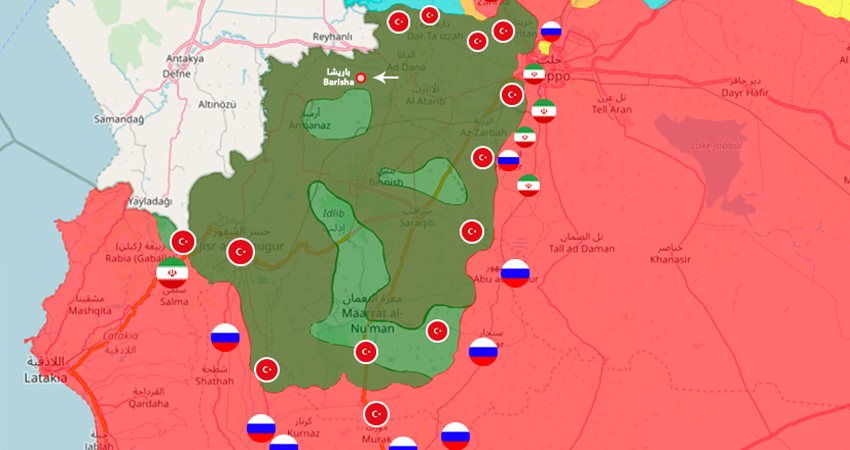
1 comment
payment